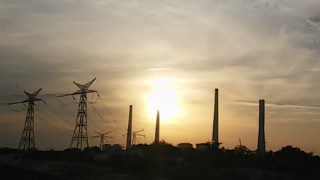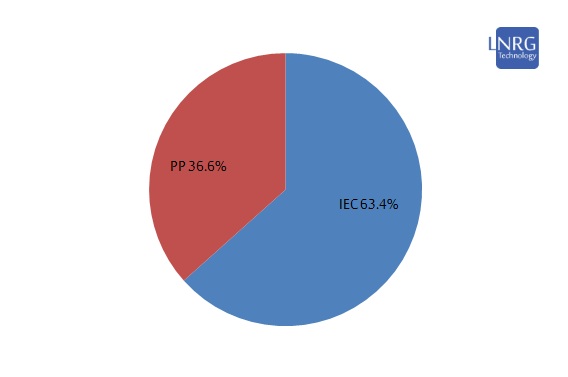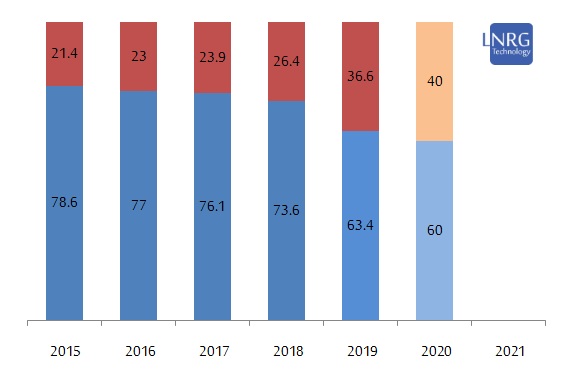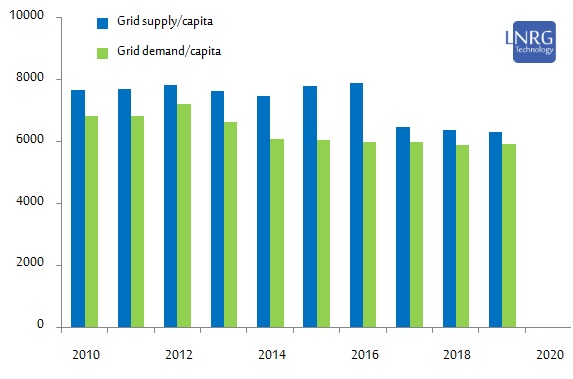
This report encloses 2019-20 developments and statistics of the Israeli electricity market with emphasis on the power generation segment. 2019 was notably influenced by the Electricity Market reform of July 2018 and the connection of the Leviathan gas field to the national gas network, while in parallel a significant progress continued in the renewables segment with integration of hundreds of MWp in 2019 and 2020. By the end of 2019, Israeli national electric generation capacity was at 19.3 GWp, with IEC making up 63.4% of total grid-connected capacity, while private producers made up the remaining 36.6%. In terms of electricity generation and supply, 72.5 million kWh were produced in 2019 in the Israeli market, up from 69.6 million kWh in 2018. That year, the generation segment was relying on a mix of fuels, dominated by natural gas and coal - both utilized by the Israel Electric Corp (IEC) as primary fuels. Secondary fuels of the IEC were diesel, oil fuel and methanol. Private power generation facilities were primary relying on natural gas, while diesel, oil fuel, kerogen and renewables were secondary energy sources.
2019 was notably influenced by the Electricity Market reform of July 2018 and the connection of the Leviathan gas field to the national gas network, while in parallel a significant progress continued in the renewables segment with integration of hundreds of MWp in 2019 and 2020. The first IEC privatization tender for Alon-Tavor power plants compound was finalized in summer 2019 and executed in the second half of the year, while the second tender for Neot Hovav power plant compound was closed in December 2019 and finalized in June 2020. By the end of 2019, Israeli national electric generation capacity was at 19.3 GWp, with IEC making up 63.4% of total grid-connected capacity, while private producers made up the remaining 36.6% (including renewables). By the end of 2020, national electric capacity is expected to reach 21.4 GWp, while the installed capacity of private electricity generation facilities is expected to surpass 40.0% share (including renewables) and is expected to reach as much as 60.0% share by 2025.

Figure 1. Installed electricity generation capacity in Israel as of December 2019 by producer: IEC (blue) and Private Producers including renewables (red).
For the past decade, the IEC has been denied from building new conventional power plants, thus practically all conventional additions have been made by the private sector. The IEC capacity further reduced upon retirement of some generation units in 2019. In terms of privately-held conventional generation, several power plants began continuous operation: the Dead Sea Industries 222 MWp gas-powered cogeneration plant received license in 2019; Ramat Gavriel power plant received permanent generation license in November 2019; the 300 MWp pump accumulation power plant in Maaleh Gilboa entered partial operation in late 2019 and second unit began operation in summer 2020; OPC Hadera power plant received permanent operation license in July 2020. In regard to renewable electricity generation, much new solar capacity was installed, adding some 719 MWp on the course of 2019, including 272 MWp thermal solar Ashalim A and B plots and 447 MWp solar PV. Solar electricity generation segment hence grew to about 1,960 MWp of grid-connected capacity by the end of 2019, and is expected to surpass 3,300 MWp by the end of 2020. Wind energy segment remained stable through 2019, with a total of four existing wind farms in Northern Israel; no new wind capacity is expected in 2020. Hydropower capacity remained stable in 2019 and is not expected to change in 2020. Finally, two small-scale biogas plants were added in 2019.
Future deployment of generation includes transfer of the 1,150 MWp Neot Hovav power generation complex from the IEC to the tender winning consortium by Shikun veBinui & Adeltek; construction of solar+storage facilities as part of the first tender of this kind concluded in 2020 - 100 MWp by Doral, 41 MWp by Enlight and 20 MWp by Ellomay Capital; tender quota of 271 MWp small natural gas generation facilities was closed in November 2019 and will be gradually deployed in upcoming years. Around 12 GWp renewable capacity is planned to be installed by 2030, thus about 1,000 MWp of mainly solar capacity is to be installed annually in upcoming years. Finally, by 2023 two coal generation units of the IEC in Hadera are to be retired in favor of a 1,200 MWp gas power plant.

Figure 2. Installed electricity generation capacity evolution by producer in Israel (percent of total) as of December each year 2015-19 and 2020 projection: IEC (blue) and Private Producers including renewables (red).
In terms of electricity generation and supply, 72.5 million kWh were produced in 2019 in the Israeli market, up from 69.6 million kWh in 2018. IEC produced 65.9% and added with electricity purchased from private producers, the IEC altogether controlled 77.8% of total electricity supply, whereas the remaining 22.2% consisted of output supplied by private producers directly to customers or schemes of self-consumption (small PV producers and three conventional power plants). Private generation share hence reached 34.1% during 2019 and is expected to continue rising through 2020 to surpass 38%. This implies a significant overshoot of governmental original target of 20% private electricity production by 2020.

Figure 3. Supply of electricity by producer in Israel during 2019: IEC (blue), Private Producers who sell directly to consumers (red) and Private Producers who sell electricity to IEC for later distribution (green).
In 2019, the generation segment was relying on a mix of fuels, dominated by natural gas and coal - both utilized by the IEC as primary fuels. Secondary fuels of the IEC were diesel, oil fuel and methanol. Private generation facilities were primary relying on natural gas, while diesel, oil fuel and renewables were secondary energy sources. When combined, the electricity generation segment continued to be dominated by natural gas as the primary energy source (60.8% by capacity, 63.4% by generation), with coal as the secondary source (25.6% by capacity, 32.8% by generation) and third place taken by renewables (10.5% by capacity, 5.0% by generation) – predominantly solar PV technology (8.9% by capacity, 3.6% by generation). Other sources, including other fossil fuels contributed a tiny fraction (1.1% of total capacity, 1.1% of total generation). In 2020, renewables' share is expected to experience further growth, reaching about 12% of total capacity and 7% of total generation.

Figure 4. Capacity of the electricity generation segment in Israel by primary fuel type as of December 2019. Notes: diesel is calculated combined with methanol; natural gas is including both CNG and LNG.
In 2019, grid supply per capita slightly decreased from 6.4 thousand kWh in 2018 to 6.3 thousand kWh annually, whereas the electricity demand per capita also remained stable at 5.9 thousand kWh annually. Total electricity generation per capita in Israel was 8.1 thousand kWh annually, slightly increasing from 2017 and 2018, when it was at 7.8 thousand kWh.

Figure 5. Development of grid demand and grid supply per capita in Israel during 2010-18.
In the past, the Electricity Authority estimated that the growth in electricity demand in upcoming years is to be at 2.7% annually, which is slightly above the demographic growth rate. The growth of electricity demand in Israel in 2018 was just about 2.0%, but rebounded to 4.1% annual growth in 2019; this year (2020) will likely experience flat growth due to the Covid19 crisis. Though there is still a total electricity demand growth due to demographic expansion, the only expectation for electricity demand growth is wide-spread adoption of electric vehicles in the near future.
The transmission and distribution segments continued to be controlled by the IEC, but after the adoption of the Electricity Reform, the grid control department was split into a separate company in 2019 and received operation license in June 2020. Distribution segment has about 10% share controlled by the Kibbutzim and the rest by IEC; more players are expected to enter this segment upon the implementation of the market reform.
The off-grid electricity market in Israel is essentially small, estimated at only several megawatts deployed in desolate locations, including diesel generators and solar PV collectors.
The premium member data page access and extended commercial report can be purchased at LNRG Technology digital store.
















